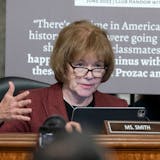Freddy Toran has been on a mission to persuade people living on the streets to get vaccinated against COVID-19 ever since his 82-year-old father abruptly died from the virus two years ago.
It's been a tough sell. Toran, 59, a longtime homeless advocate and volunteer at a Minneapolis shelter, said he sometimes has to pull out his smartphone and show a video of his father's dying moments — when he was struggling to breathe in a nursing home — before a person experiencing homelessness will commit to the potentially lifesaving shots.
"It's really hard to think about vaccines when you have no transportation and you're too busy worrying about where you have to sleep that night," said Toran, an organizer with Freedom from the Streets, a Twin Cities advocacy group led by homeless people. "But this [virus] is real — as real as it gets."
His experience underscores the persistent challenge of getting vaccines to hard-to-reach populations.
An expansive new study found that rates of vaccination among Minnesotans who are homeless or in jail are drastically lower than in the general population, suggesting they are not getting equal access to the shots despite aggressive outreach. About 34% of homeless Minnesotans were fully vaccinated at the end of 2021, compared with 64% of other Minnesotans. The disparities worsened as booster shots were rolled out last year. Statewide, the general population has received a booster shot at four times the rate of homeless and jail populations, according to the study.
The findings, published last week in the journal Health Affairs, raise fresh questions about the state's strategy for distributing shots, and suggest that more targeted approaches are necessary to reach marginalized groups. Early last year, Gov. Tim Walz's administration opened community vaccination sites across the state and offered a host of incentives — including $100 gift cards and free state park passes — to encourage more Minnesotans to get the shots. Community health providers and volunteer physicians organized vaccination drives in churches, schools and even breweries.
Meanwhile, Hennepin County Health Care for the Homeless continues to offer vaccinations at shelter and outreach sites throughout Minneapolis, as well as at homeless encampments through its outreach teams.
Even with these efforts, vaccination rates lagged significantly for Minnesotans who are homeless or in jails — highly transient populations that face transportation and other barriers to getting to vaccination sites. The approximately 8,000 Minnesotans who sleep outside or in emergency shelters are considered particularly vulnerable to the virus because they have high rates of chronic health problems and spend so much time in public. The cramped conditions of many shelters, where people sleep on bunks just feet apart, can make it difficult to avoid airborne pathogens.


